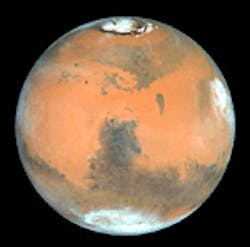A Reason For the Red in Mars
A new theory about ancient Mars supports the idea that the Red Planet was once potentially habitable.
Ancient acidic seas, similar to those found in one region of Spain, may explain the Red Planet's uniquely tinted geology.
In an article posted on space.com by senior science writer Robert Roy Britt, he asserts: "Orange minerals tint the rocks in Spain's Tinto River region, where the water is highly acidic. The water chemistry on ancient Mars may have been similar."
If the seas of Mars were moderately acidic — in scientific terms, a pH under 6 instead of the pH of 8 common to terrestrial oceans — then carbonates could not have formed, Alberto Fairen of the Universidad Autonoma de Madrid, in Spain told Britt. The study is detailed in Thursday's issue of the journal Nature.
In southwest Spain, the Tinto River has a mineralogy similar to the Meridiani Planum, where NASA's Opportunity rover found strong evidence for long-gone standing water, possibly a lake or maybe even an ocean. Minerals such as jarosite and hematite are common to both locations, Fairen said.
What's more, the Tinto River's acidic environment supports a rich biosphere. "Life is highly diverse in the Tinto system, allowing us to suggest comparable ancient acidic aquatic habitats hosting a putative early biosphere on Mars," Fairen and his colleagues contend in the journal.
"In this scenario, the origin of life [on Mars] is a probable event," Fairen said.
Source: space.com
